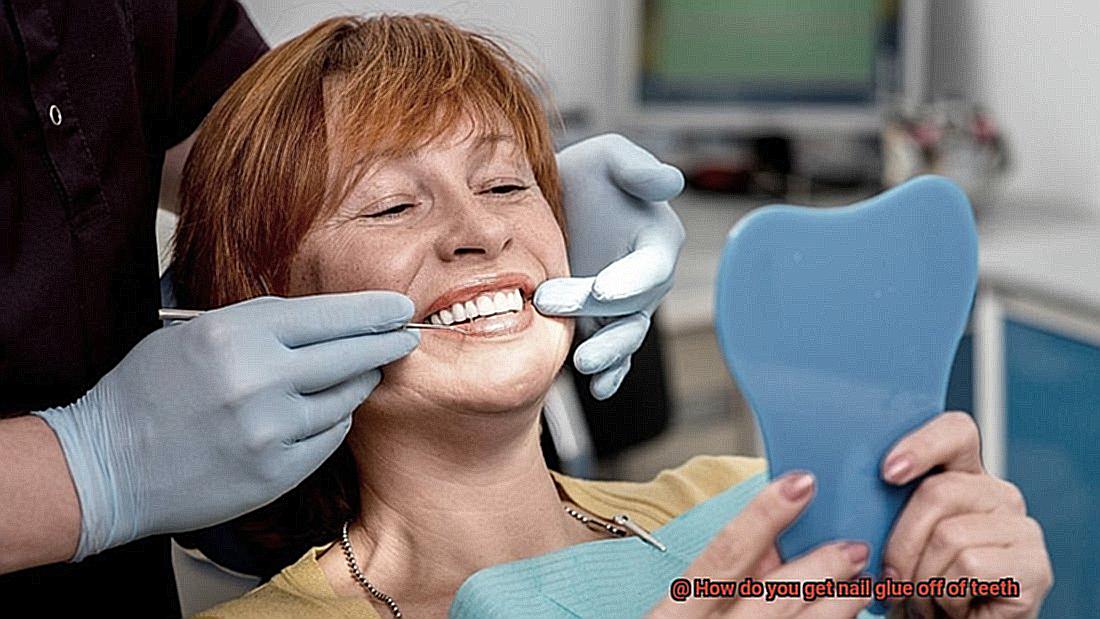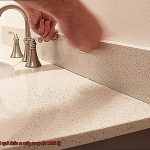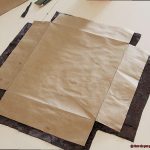Picture this: you’ve just finished applying a fresh set of nails and in your excitement, accidentally got some nail glue on your teeth. Panic sets in as you try to frantically scrub it off before anyone notices. We’ve all been there, but fear not my friend, because I’m here to help you out.
First things first, do not attempt to scrape off the glue with your nails or any sharp object. This could potentially cause damage to your teeth and make matters worse in the long run. Instead, we’ll be exploring gentler yet effective techniques to remove the stubborn glue.
In this post, we’ll delve into various methods such as using oil-based products like coconut oil or olive oil to dissolve the glue, or even dental floss or a toothpick to carefully scrape it off. Whatever your preference may be, we’ve got you covered.
Whether you’re in a rush to fix a nail or simply had a mishap, this post will provide you with all the tips and tricks needed to quickly and safely remove nail glue from your teeth. So let’s dive right into it.
What is Nail Glue?
Contents
- 1 What is Nail Glue?
- 2 Why Do You Need to Remove Nail Glue from Teeth?
- 3 How to Remove Nail Glue from Teeth: Warm Water and Gentle Scrubbing
- 4 How to Remove Nail Glue from Teeth: Acetone-Based Nail Polish Remover
- 5 Risks of Using Acetone-Based Nail Polish Remover on Teeth
- 6 When to Seek Professional Help for Removing Nail Glue from Teeth
- 7 Tips for Preventing Nail Glue from Getting on Teeth
- 8 Home Remedies for Removing Nail Glue from Teeth
- 9 Conclusion
Nail glue, also known as nail adhesive, is an essential tool in the world of beauty and personal care. It is a strong and fast-acting adhesive that is used to bond artificial or acrylic nails to natural nails, as well as to repair broken nails or attach fake nails for a temporary period. The glue usually comes in small bottles with a narrow applicator tip for precise application, making it easy to use even for those with little experience.
The main ingredient in nail glue is cyanoacrylate, a powerful adhesive that reacts with moisture in the air or on the surface it is applied to. This unique property allows it to adhere quickly and strongly to surfaces, including skin and teeth. However, it is important to note that accidents can happen where the glue comes into contact with other parts of the body, such as the skin or teeth.
When it comes to removing nail glue from teeth, time is of the essence. The longer the glue sits on the teeth, the harder it becomes to remove. Therefore, it is important to act quickly when trying to remove nail glue from your teeth. The best way to remove nail glue from teeth is by using warm water and gentle scrubbing. Start by rinsing your mouth with warm water. This will help to loosen the glue and make it easier to remove.
If warm water and gentle scrubbing don’t work, you can try using a small amount of acetone-based nail polish remover. However, this should only be used as a last resort since ingesting even a small amount of acetone can be harmful and cause damage to your body. It is always recommended to consult with a dental professional if you have any doubts about how to safely remove nail glue from your teeth.
Why Do You Need to Remove Nail Glue from Teeth?
Leaving nail glue on your teeth can cause serious damage to your oral health. That’s why it’s crucial to remove nail glue from teeth as soon as possible.
Nail glue contains chemicals that are not meant to be ingested or come into contact with teeth. When left on teeth for too long, it can cause tooth decay, gum irritation, and even infection. Swallowing the nail glue accidentally can also lead to serious health complications. So, removing it from your teeth is not just about avoiding embarrassment, but also preventing serious health issues.
Moreover, if left on teeth for too long, nail glue can affect your appearance. It can make your teeth look discolored or stained and attract food particles and bacteria, leading to bad breath. Nobody wants that. So, removing it from your teeth is also crucial for maintaining your confidence level.
So, how do we remove nail glue from teeth safely? The first step is to act quickly and rinse your mouth with warm water immediately. If gentle scrubbing with a toothbrush and warm water doesn’t work, it’s best to consult with a dental professional before resorting to acetone-based nail polish remover. Using harsh chemicals without proper guidance can harm your teeth and gums.
How to Remove Nail Glue from Teeth: Warm Water and Gentle Scrubbing
If you find yourself dealing with nail glue on your teeth, it’s important not to panic. Thankfully, there are effective ways to remove it safely – one of the most popular methods being warm water and gentle scrubbing. Let’s dive into five sub-sections that will break down this method into easy-to-follow steps, helping you restore your smile in no time.
Begin with Warm Water
The first step in removing nail glue from teeth using warm water and gentle scrubbing is to fill a cup with warm water and take a sip, swishing it around your mouth for a few seconds before spitting it out. Repeating this process a few times helps to loosen the glue.
Use a Soft-Bristled Toothbrush
After rinsing your mouth thoroughly, wet a soft-bristled toothbrush under warm water and gently brush the affected area. Be careful not to brush too hard, as this can cause damage to your teeth and gums. Instead, use small circular motions and focus on the glue itself rather than the surrounding teeth.
Be Patient
Removing nail glue from your teeth requires patience, so take your time. Continue brushing until all of the glue has been removed.
Try Flossing or Cotton Swabs
If there are still traces of glue left after brushing, try using dental floss or cotton swabs to remove it. This can be particularly helpful for hard-to-reach areas.
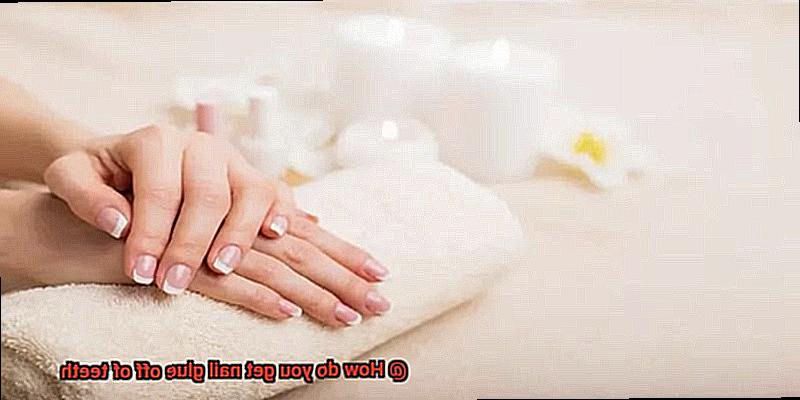
Consult a Professional
If warm water and gentle scrubbing aren’t enough to remove the glue, don’t hesitate to consult with a dental professional. They can offer additional advice and may use specialized tools to remove the glue safely.
How to Remove Nail Glue from Teeth: Acetone-Based Nail Polish Remover
Accidentally getting nail glue on your teeth is a common problem. However, don’t worry. Acetone-based nail polish remover can be an effective solution to remove the glue from your teeth. In this article, we will provide you with step-by-step instructions on how to use this method.
Step 1: Prepare the Materials
Before starting the process, make sure you have everything you need:
- Cotton swabs or balls
- Acetone-based nail polish remover
- Water
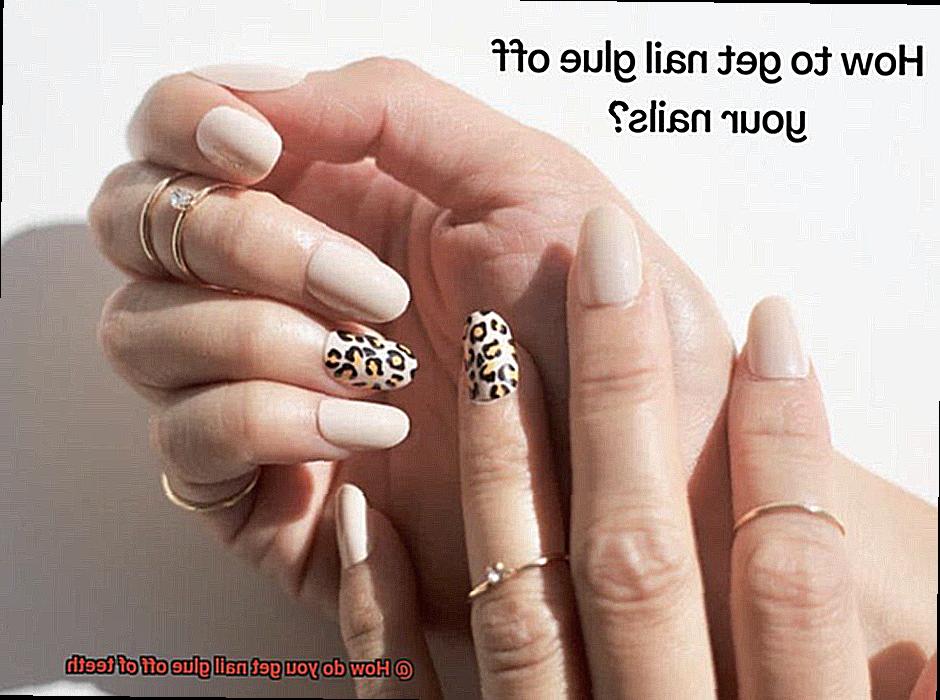
Step 2: Soak the Cotton Swab/Ball in Acetone
Soak a cotton swab or ball in the acetone-based nail polish remover. You don’t need too much of it, just enough to cover the affected area.
Step 3: Apply the Acetone to Your Teeth
Gently rub the cotton swab or ball on the affected area of your teeth. Remember to be careful not to rub too hard as this can damage your teeth and gums. Keep rubbing until you see the glue start to dissolve and come off your teeth.
Step 4: Rinse Your Mouth with Water
Once all the glue has been removed, rinse your mouth thoroughly with water. This will help get rid of any remnants of the nail polish remover.
Step 5: Repeat if Necessary
If there is still some glue remaining, repeat the process until all of it has been removed.
It’s important to note that acetone-based nail polish remover should only be used as a last resort if other methods have failed. Additionally, be cautious as acetone can be harsh on your teeth and gums. If you experience any discomfort or sensitivity while using it, stop immediately and consult your dentist for further advice.
In addition to using acetone-based nail polish remover, warm water and gentle scrubbing can also be effective in removing nail glue from teeth. Remember to act quickly when trying to remove the glue, as it becomes more difficult to remove the longer it sits on your teeth. As always, if you are unsure about how to remove nail glue from your teeth, consult with a dental professional for guidance.
Risks of Using Acetone-Based Nail Polish Remover on Teeth
Accidentally getting nail glue on your teeth can be an alarming situation. To remove the glue, many people turn to acetone-based nail polish remover, which is commonly used to dissolve adhesives. However, it’s crucial to understand the risks that come with using this chemical solvent on your teeth.
Acetone is a powerful irritant that can cause significant damage to the tissues in your mouth and throat. When applied directly to teeth, acetone can strip away the protective enamel layer, leaving your teeth vulnerable to sensitivity, discoloration, cavities, and other dental issues.
Not only that, but frequent use of acetone on your teeth can also cause dryness and cracking of your lips and gums, leading to discomfort and pain. A quick fix could potentially lead to long-term damage.
Therefore, it’s essential to explore safer alternatives when dealing with dental issues. If you find yourself in a situation where you have nail glue on your teeth, try using warm water and a soft-bristled toothbrush. Gently scrub the affected area until the glue dissolves.
If this method doesn’t work, don’t fret. Seek professional help from a dentist who can safely remove the glue without causing any harm to your oral health. It’s always better to err on the side of caution than risk damaging your teeth or causing harm to your mouth’s tissues.
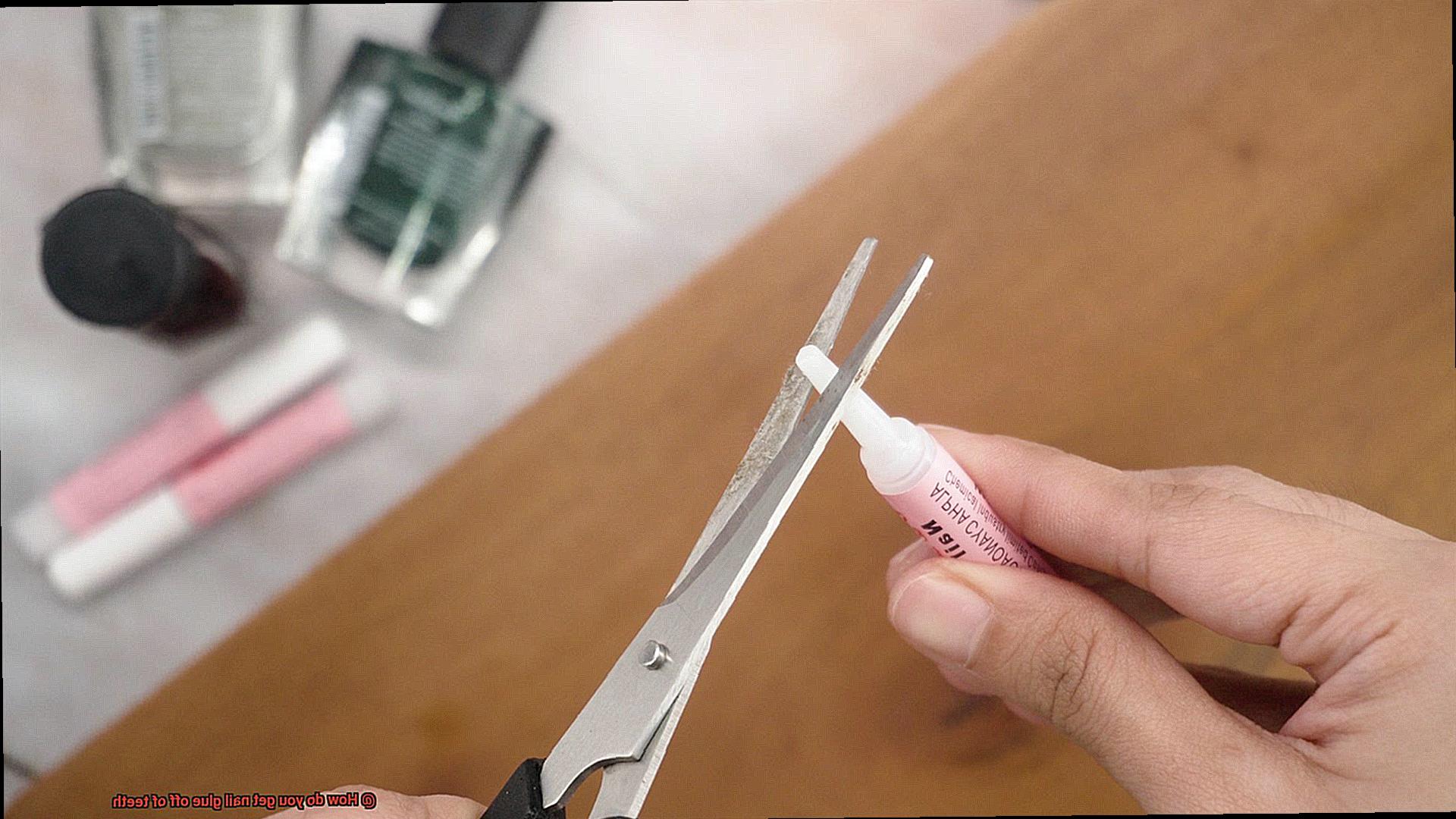
When to Seek Professional Help for Removing Nail Glue from Teeth
Imagine you’re working on your nails, but accidentally get nail glue on your teeth. Don’t panic. As an expert in dental care, I’m here to advise you on when to seek professional help for removing nail glue from teeth.
First and foremost, if the nail glue covers a large area of your teeth or has been left on for a prolonged period, it’s best to see a dentist. Attempting to remove it yourself could cause damage to your teeth or gums. A dental professional has the necessary tools and knowledge to safely remove the glue without causing any harm.
Moreover, experiencing pain or discomfort due to nail glue is a red flag that you should seek professional help as soon as possible. Pain could be an indication of damage to the tooth or gum tissue, and early treatment is crucial in preventing further damage.
It’s also important to avoid using household items or techniques to remove nail glue from your teeth, such as sharp objects or abrasive materials, which can scratch or damage your teeth and gums. Trust me, it’s not worth the risk.
In conclusion, if you’re unsure how to safely and effectively remove nail glue from your teeth, always seek professional help. Your dental health is too valuable to take any chances with. Remember these tips:
Tips for Preventing Nail Glue from Getting on Teeth
Preventing nail glue from getting on your teeth is crucial to avoid the need for removing it later. Nail glue can be a strong adhesive that is often used to attach artificial nails to natural nails. However, if the glue accidentally gets on teeth, it can be a frustrating and potentially harmful experience. To prevent this, here are some tips to follow:
Apply Precisely
When applying nail glue, always make sure to apply it carefully and precisely. Try not to let the glue touch your teeth and use a small amount of glue on the nail. Avoid using too much glue, as this may lead to spreading onto other areas. Instead of using your fingers, use a cuticle stick to apply the glue precisely to the nail. This will help you avoid any accidental contact with your teeth.
Create a Barrier
If you have a habit of getting nail glue on your teeth, consider covering them with tissue or cotton pad while applying the glue. This will create a barrier between your teeth and the glue and prevent any accidental contact. You can also use a mouthguard or dental wax when applying nail glue to create a protective barrier between your teeth and the glue.
Clean Immediately
If you accidentally get nail glue on your teeth, clean it up immediately with a soft-bristled toothbrush and warm water. Don’t use any sharp or abrasive tools as they can damage your teeth. Make sure to remove all traces of the glue because if left unattended, it can harden and become difficult to remove.
Be Mindful of Movements
It is important to be mindful of your movements while the glue is drying. Avoid touching your face or mouth during this time, as this can cause the glue to transfer onto your teeth. Try not to talk or laugh until the glue has completely dried, as this may lead to accidental contact with your teeth. Additionally, avoid eating or drinking until the glue has completely dried.
Home Remedies for Removing Nail Glue from Teeth
Don’t worry, it happens to the best of us. Fortunately, there are several home remedies that can help you remove the pesky glue without causing any damage to your teeth and gums. Let’s explore some of the most effective methods:
- Warm water and toothbrush method: This is a simple and straightforward method that involves using warm water and a soft-bristled toothbrush. Gently scrub the affected area with the toothbrush and warm water to loosen the glue. This method is perfect for those who want to avoid using any harsh chemicals or ingredients.
- Baking soda and hydrogen peroxide method: If you’re looking for a more potent solution, try mixing equal parts of baking soda and hydrogen peroxide to create a paste. Apply this paste directly to the glue and let it sit for a few minutes before gently scrubbing with a toothbrush and rinsing with warm water. This method is great for those who want a more powerful option that can break down the glue quickly.
- Vinegar or lemon juice method: For those who prefer natural remedies, vinegar or lemon juice can be used to remove nail glue from teeth. Soak a cotton ball in either liquid and apply it to the affected area. Let it sit for a few minutes before wiping away the glue. This method is perfect for those who want an all-natural solution that won’t cause any harm to their teeth.
It’s important to be cautious when using these home remedies as aggressive scrubbing or using abrasive materials can damage your teeth and gums. Remember to be gentle and take your time when attempting to remove nail glue from your teeth.
Conclusion
In conclusion, finding nail glue on your teeth can be a frustrating experience that requires immediate action to avoid potential damage to your oral health. Luckily, there are safe and effective methods for removing it.
The simplest and safest method involves using warm water and gently scrubbing with a soft-bristled toothbrush. However, if this method fails, acetone-based nail polish remover can be used as a last resort. It’s important to use this method with caution and only in small amounts due to the risks associated with enamel damage and gum irritation.
If you experience pain or discomfort while attempting to remove the glue, seeking professional help from a dental professional is always recommended.
Preventing nail glue from getting on your teeth is crucial. Applying the glue precisely, creating a barrier between your teeth and the glue, cleaning immediately if there’s accidental contact, being mindful of movements while the glue dries, and avoiding eating or drinking until it has completely dried are some tips that can help prevent this mishap.
Fortunately, several home remedies like warm water and toothbrush method, baking soda and hydrogen peroxide method, or vinegar/lemon juice method can effectively remove nail glue from teeth without causing any harm. These methods should be used gently and with patience for optimal results.
In short, removing nail glue from teeth requires prompt action and careful consideration of potential risks.

